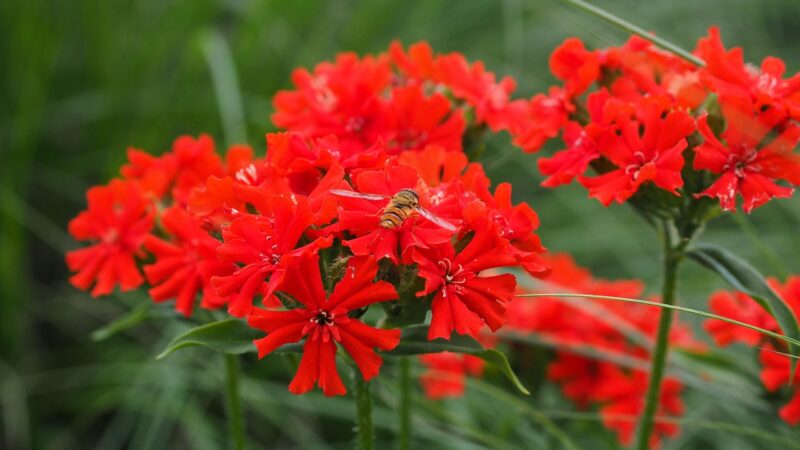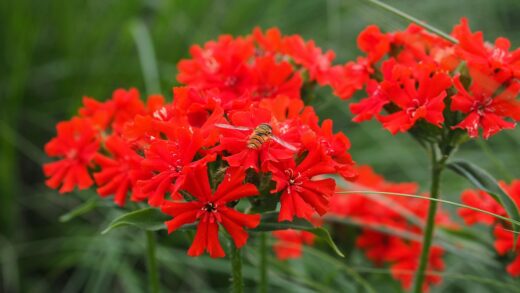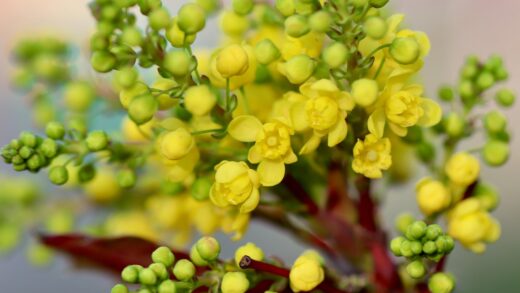The care of Maltese cross

The Maltese cross is a truly captivating perennial plant, known for its vibrant scarlet-orange flower heads that command attention in any garden setting. Its historical significance and striking appearance make it a cherished choice for both novice and experienced gardeners seeking a touch of brilliance and tradition. Proper care ensures this hardy plant will thrive and return year after year, providing a spectacular display of color throughout its blooming season. Understanding its fundamental needs, from soil composition to its preferred location, is the first step towards cultivating a healthy and robust specimen that will become a focal point of your summer garden.
Understanding the fundamentals
The Maltese cross is renowned for its resilience and relatively low-maintenance nature, making it an excellent addition to a wide range of garden designs. This herbaceous perennial typically grows in upright clumps, reaching a height of about two to three feet, and it is particularly valued for its densely packed, spherical flower heads. Each flower head is composed of numerous small, cross-shaped florets, which give the plant its distinctive and symbolic name. The bloom time usually occurs in early to mid-summer, offering a burst of intense color that bridges the gap between spring and late-summer flowers. Appreciating these basic characteristics helps in planning its placement and integration into a perennial border or wildflower meadow.
Beyond its aesthetic appeal, the plant is also a valuable resource for pollinators, attracting a variety of bees, butterflies, and even hummingbirds to the garden. This ecological benefit enhances the overall health and biodiversity of your garden ecosystem, making the Maltese cross a functional as well as a beautiful choice. The plant’s foliage consists of lance-shaped, green leaves that provide a pleasant backdrop for the brilliant flowers. These leaves remain attractive throughout the growing season, contributing to the plant’s overall appeal even when it is not in bloom. Its sturdy stems generally do not require staking, unless planted in a particularly windy location or in overly rich soil that encourages leggy growth.
Successfully cultivating the Maltese cross begins with an appreciation for its native habitat, which informs its basic cultural requirements. Originating from Eastern Europe and parts of Asia, it is well-adapted to a range of conditions but performs best in environments that mimic its natural setting. It has naturalized in many other parts of the world, a testament to its adaptability and hardiness. Therefore, providing it with conditions that are not overly coddled is often the key to success. A gardener who understands its preference for sun, well-drained soil, and moderate moisture will be rewarded with a profusion of its signature fiery blooms.
Ultimately, the long-term health of the plant depends on a holistic approach to its care, considering all aspects from initial planting to seasonal maintenance. While it is a forgiving plant, attention to its needs will result in a more vigorous and floriferous specimen. This includes providing adequate spacing to ensure good air circulation, which helps prevent fungal diseases, and performing timely maintenance tasks such as deadheading to encourage further blooming. By embracing these straightforward care principles, you can ensure that your Maltese cross remains a stunning and healthy component of your garden for many years to come.
More articles on this topic
Selecting the ideal location
Choosing the right spot in your garden is arguably the most critical factor in ensuring the success of your Maltese cross. This plant is a true sun-worshipper and requires a location that receives at least six to eight hours of direct sunlight each day. Insufficient light will lead to weak, leggy stems that may be unable to support the weight of the flower heads, resulting in a floppy and untidy appearance. Furthermore, a lack of adequate sunlight will significantly reduce the number and intensity of the blooms, depriving you of the plant’s main ornamental feature. An open, sunny position is therefore non-negotiable for achieving the best possible display.
When considering a location, it is also important to think about the plant’s mature size and its relationship with its neighbors. The Maltese cross forms a clump that can spread to about 18 inches in diameter, so it needs adequate space to grow without being crowded by other plants. Good air circulation around the plant is crucial for preventing common fungal diseases like powdery mildew, which can thrive in damp, stagnant conditions. Planting it alongside companions that have similar light and water requirements will create a harmonious and healthy garden bed where all plants can flourish.
The visibility of the plant should also be a key consideration in its placement. The intense, fiery color of the Maltese cross makes it an exceptional focal point in a perennial border, and it pairs beautifully with plants that have blue, purple, or yellow flowers, creating a stunning visual contrast. Consider planting it in the middle of a border where its height can be appreciated without obscuring smaller plants in the front, and where it is framed by other complementary perennials. It also works well in cottage gardens, wildflower meadows, and even in large containers, as long as its need for sun is met.
Finally, assess the microclimate of the potential planting site. Avoid low-lying areas where water tends to collect, as the Maltese cross is intolerant of waterlogged soil, especially during the winter months. A spot with a slight slope can be beneficial for ensuring excellent drainage. Also, while the stems are quite sturdy, a location with some protection from strong, prevailing winds can help prevent them from breaking, particularly when they are heavy with blooms. Taking the time to evaluate these factors will pay dividends in the form of a thriving and beautiful plant.
More articles on this topic
Preparing the soil
Proper soil preparation is fundamental to the long-term health and vigor of the Maltese cross. This plant thrives in soil that is well-drained, a characteristic that cannot be overemphasized. It is adaptable to a range of soil types, including sandy, loamy, and clay soils, but it will not tolerate consistently wet or waterlogged conditions, which can quickly lead to root rot. Before planting, it is essential to assess the drainage of your chosen site. A simple test involves digging a hole about a foot deep and filling it with water; if the water has not drained away within a few hours, your soil likely has poor drainage that needs to be addressed.
To improve heavy clay soil and enhance its drainage, incorporate generous amounts of organic matter such as compost, well-rotted manure, or leaf mold. This will help to break up the dense clay particles, creating a more friable structure that allows water to pass through more easily and provides channels for root growth. For sandy soils, which drain too quickly and have poor nutrient retention, adding organic matter will help to bind the soil particles together and improve their ability to hold both moisture and essential nutrients. The goal is to create a balanced, loamy soil that retains some moisture but allows excess water to drain away freely.
The ideal soil pH for Maltese cross is in the neutral to slightly alkaline range, typically between 6.5 and 7.5. Most garden soils fall within this range, but it can be beneficial to conduct a simple soil test to be certain. If your soil is overly acidic, you can amend it by adding garden lime according to the test recommendations. Conversely, if the soil is too alkaline, incorporating elemental sulfur or organic materials like pine needles can help to lower the pH over time. However, the Maltese cross is generally not overly sensitive to pH, and good drainage is a far more critical factor for its success.
Before planting, cultivate the soil to a depth of at least 12 to 15 inches, removing any weeds, rocks, or other debris. This deep cultivation loosens the soil, making it easier for the plant’s roots to establish themselves and penetrate deep into the ground. At this stage, you can work in a balanced, slow-release granular fertilizer or a layer of compost to provide a nutrient base that will support the plant through its first growing season. Proper soil preparation provides a foundation for a healthy root system, which is essential for the overall resilience and performance of the plant.
Watering practices
Once established, the Maltese cross is a remarkably drought-tolerant plant, a trait it inherited from its native growing conditions. This makes it a suitable choice for water-wise gardens and for gardeners who prefer a more low-maintenance landscape. During its initial establishment phase, however, regular watering is crucial for developing a strong and extensive root system. For the first few weeks after planting, the soil should be kept consistently moist but not saturated. This encourages the roots to grow outwards and downwards in search of moisture, anchoring the plant securely and preparing it for future periods of drought.
After the first growing season, the plant’s watering needs will decrease significantly. An established Maltese cross will typically only require supplemental watering during prolonged periods of heat and drought. A good rule of thumb is to check the soil moisture; if the top two to three inches of soil are dry, it is time to water. When you do water, do so deeply and thoroughly, allowing the water to soak far into the soil profile. This deep watering encourages the roots to grow deeper, making the plant even more resilient to dry conditions, unlike frequent, shallow watering which promotes a weak, shallow root system.
It is important to apply water directly to the base of the plant, avoiding the foliage as much as possible. Wetting the leaves, especially in the evening, can create a humid environment that is conducive to the development of fungal diseases such as powdery mildew. Using a soaker hose or drip irrigation system is an efficient and effective way to deliver water directly to the root zone where it is needed most, while also minimizing water loss through evaporation. If you are using a watering can or hose, aim for the soil around the plant rather than spraying the entire plant from above.
Observing the plant is one of the best ways to gauge its watering needs. If you notice the leaves beginning to wilt or droop during the heat of the day, this is a clear sign that the plant is thirsty. While it can recover quickly from mild wilting, it is best to provide water before this stage to avoid stressing the plant. Conversely, yellowing leaves can be a sign of overwatering, indicating that the roots may be struggling in soil that is too wet. By paying attention to these cues and adjusting your watering practices accordingly, you can maintain the optimal moisture balance for a healthy plant.
Fertilization and feeding
The Maltese cross is not a heavy feeder and generally performs well in soil of average fertility. In fact, overly rich soil or excessive fertilization can be detrimental to the plant’s health. Too much nitrogen, in particular, can stimulate lush, weak foliage growth at the expense of flowers, and can also lead to tall, floppy stems that are unable to support the flower heads. Therefore, a conservative approach to fertilization is always the best strategy for this particular perennial. A single application of a balanced, slow-release fertilizer in the spring is typically all that is required for the entire growing season.
If your soil is already rich in organic matter, you may find that no supplemental fertilizer is needed at all. A top-dressing of compost or well-rotted manure applied around the base of the plant in the spring can provide a slow and steady supply of essential nutrients throughout the season. This method has the added benefit of improving the soil structure and its moisture-retaining capacity. Organic amendments are an excellent way to feed the soil, which in turn feeds the plant, creating a healthy and sustainable garden ecosystem.
When choosing a commercial fertilizer, opt for a balanced formula, such as a 10-10-10 or a formulation specifically designed for flowering perennials. Avoid high-nitrogen fertilizers that are intended for lawns or heavy-feeding annuals. The fertilizer should be applied in early spring, just as new growth begins to emerge. Sprinkle the granular fertilizer around the base of the plant, being careful to avoid direct contact with the stems or crown, and then gently work it into the top inch of soil. Water the area well after application to help dissolve the granules and carry the nutrients down to the root zone.
Throughout the growing season, monitor the plant’s appearance. A healthy Maltese cross will have sturdy stems and vibrant green leaves. If the leaves appear pale or yellowed and growth seems stunted, it may indicate a nutrient deficiency, in which case a light feeding with a liquid fertilizer, such as a kelp or fish emulsion, can provide a quick boost. However, it is important to first rule out other potential causes, such as poor drainage or disease. In most cases, less is more when it comes to fertilizing this resilient and self-sufficient perennial.
Seasonal maintenance tasks
One of the most important seasonal maintenance tasks for the Maltese cross is deadheading, which is the practice of removing spent flowers. As the brilliant flower heads begin to fade, snipping them off at the base of their stem will not only keep the plant looking tidy but will also encourage the production of a second, albeit smaller, flush of blooms later in the season. This process redirects the plant’s energy from seed production towards creating more flowers and stronger roots. Regular deadheading throughout the blooming period can significantly extend the time you get to enjoy its vibrant display.
As summer progresses into autumn, the foliage of the Maltese cross will naturally begin to die back after the first hard frost. At this point, you can cut the entire plant back to a few inches above the ground. This tidies up the garden for the winter and can also help to prevent pests and diseases from overwintering in the dead plant material. While some gardeners prefer to leave the stems standing for winter interest and to provide habitat for beneficial insects, the Maltese cross does not have particularly noteworthy winter structure, so cutting it back is generally the recommended practice.
In the spring, as new growth emerges, it is a good time to apply a layer of mulch around the base of the plant. A two to three-inch layer of organic mulch, such as shredded bark, compost, or leaf mold, offers numerous benefits. It helps to suppress weed growth, which can compete with the plant for water and nutrients. Mulch also helps to conserve soil moisture by reducing evaporation and moderates soil temperature, protecting the roots from extreme heat in the summer. As the organic mulch breaks down, it will also gradually add nutrients to the soil, improving its overall fertility.
Every few years, typically every three to four years, the clumps of Maltese cross may become large and overcrowded, or the center of the clump may start to die out. This is a natural part of the aging process for many perennials and is a sign that the plant would benefit from division. Division is best done in the spring or early autumn. This process not only revitalizes the original plant but also provides you with new plants to expand your garden or share with fellow gardeners. This periodic division is a key aspect of the long-term care and management of a healthy clump.
Managing pests and diseases
The Maltese cross is a relatively robust and trouble-free plant, but like any garden specimen, it can occasionally fall prey to certain pests and diseases. Providing the plant with its ideal growing conditions, including full sun, good air circulation, and well-drained soil, is the most effective preventative measure. A healthy, vigorous plant is far less susceptible to problems than one that is stressed by poor conditions. Regular monitoring of your plants will allow you to spot any potential issues early and take action before they become widespread.
One of the most common diseases that can affect the Maltese cross is powdery mildew. This fungal disease appears as a white, powdery coating on the leaves and stems, and it is most prevalent in warm, humid conditions with poor air circulation. To prevent powdery mildew, ensure that you provide adequate spacing between plants to allow air to move freely. Watering at the base of the plant in the morning, rather than overhead in the evening, will also help to keep the foliage dry. If an infection does occur, affected leaves should be removed and destroyed, and in severe cases, a fungicide may be necessary.
Root rot is another potential issue, and it is almost always a result of poorly drained or waterlogged soil. The symptoms of root rot include wilting, yellowing leaves, and a general lack of vigor, and upon inspection, the roots will appear brown and mushy. Prevention is the only effective cure for root rot, so it is imperative to ensure your soil has excellent drainage before planting. If a plant is suffering from root rot, it is often best to remove it to prevent the fungal pathogens from spreading to other plants in the vicinity.
In terms of pests, the Maltese cross is not a primary target for many insects, but it can occasionally be bothered by aphids or slugs. Aphids are small, sap-sucking insects that can congregate on new growth and flower buds. They can often be controlled by a strong spray of water from a hose or by introducing beneficial insects like ladybugs into the garden. Slugs and snails may be attracted to the young foliage in the spring. These can be managed through various methods, including beer traps, diatomaceous earth, or simply hand-picking them off the plants in the evening.

















